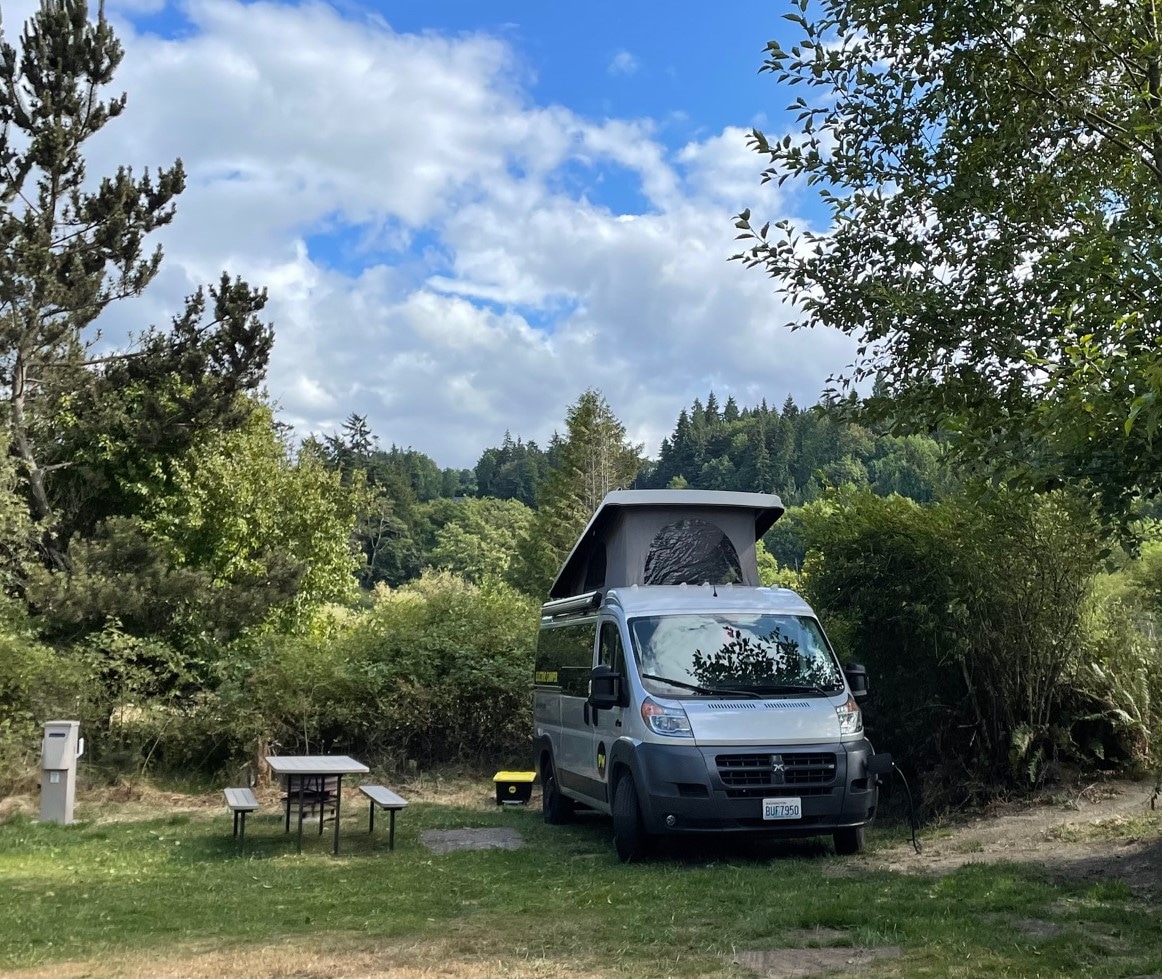
05 Aug The Best Carbon-Free Road Trip Ever!
Touring the peninsula without toasting the planet
I took my first drive in an electric vehicle twelve years ago. It was a Tesla roadster. It literally threw my head back into my seat with its acceleration. I realized at that moment the power of electric vehicles and the promise of zero-carbon transportation. Soon after, I leased my first Nissan Leaf. I’ve never looked back and have been driving, mostly, on electricity ever since.
I say mostly because I have taken some road trips on gasoline. Longer excursions have been difficult in electric vehicles. Consequently, I had to resort to internal combustion engine (ICE) vehicles several times over the last decade for longer road trips.
That’s why I was so excited to learn about the e-Tofino from PacWesty. An all-electric camper van seemed almost too good to be true. The quiet of the ride. The ease of the drive. The psychic serenity of knowing that I could access the treasures of the natural world without the guilt of harming them. I leaped at the chance to try it out.
PacWesty is focusing on sustainable travel and has committed to developing an all-electric rental fleet. The e-Tofino is very possibly the first and only electric camper available for rental in the country. It is built on a Dodge RAM ProMaster base, outfitted as a camper by Pleasure-Way in Canada, and converted to an electric motor drive by PacWesty and partner Maxwell Vehicles.
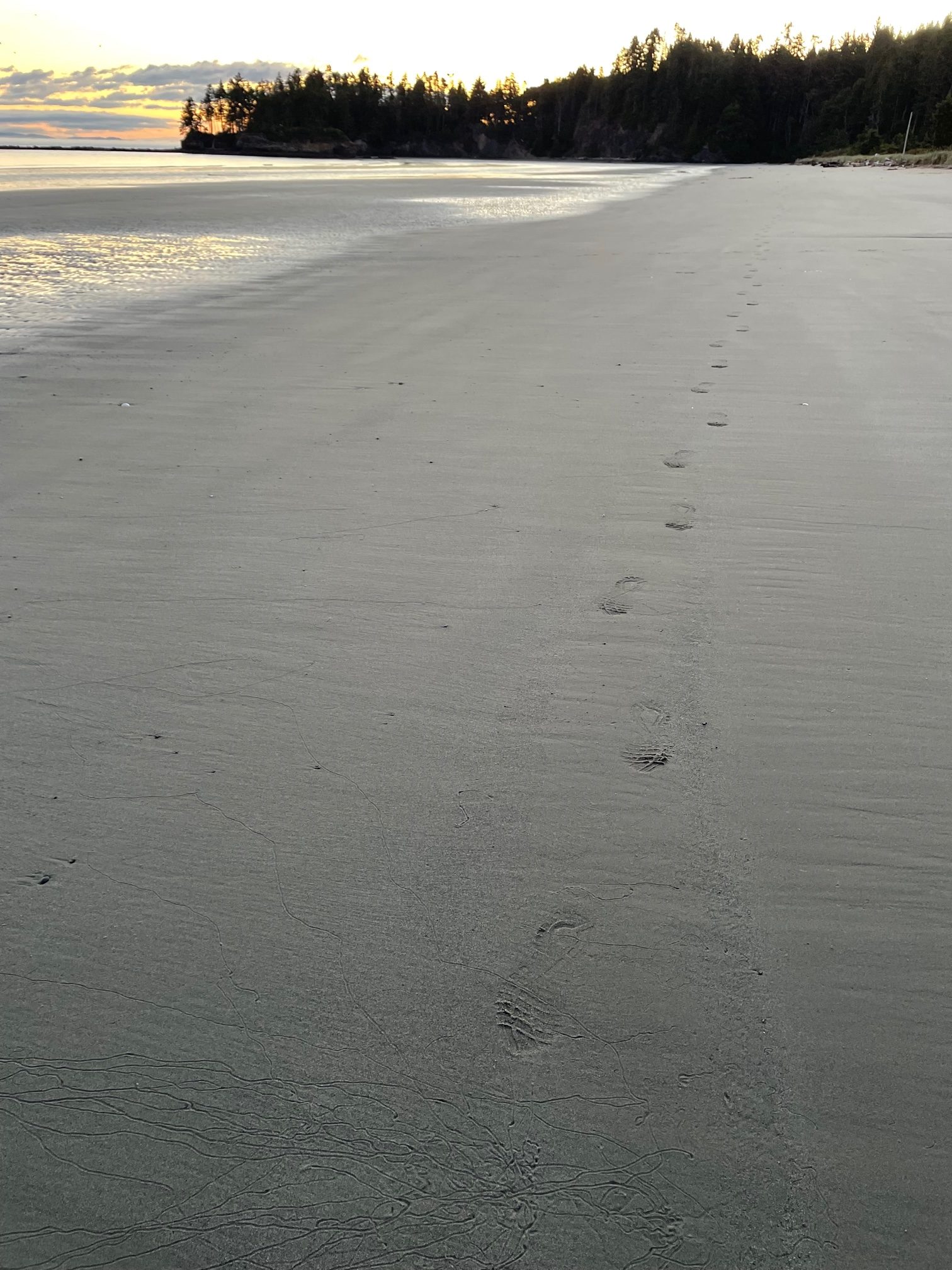
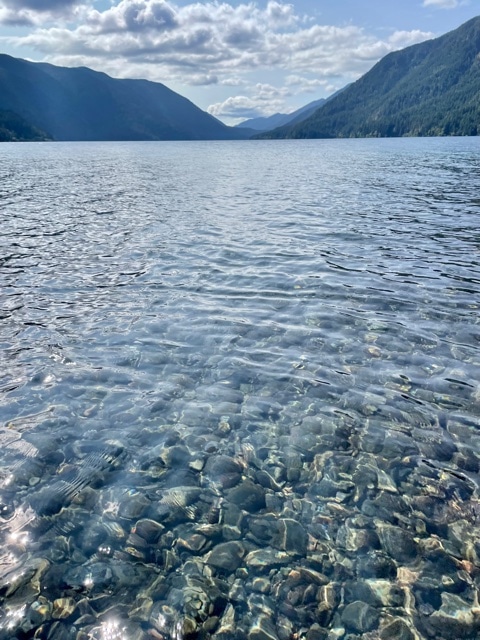
I left on my carbon-free tour of the Olympic peninsula on a Wednesday at noon from Bainbridge Island, a short ferry ride from Seattle. The PacWesty Adventure Coordinator, Luke, gave me a quick, but thorough, run-down of the gear and operations of the e-Tofino. Luke helped me select my initial destination at the Crescent Beach RV Park, a family-run business at one of the first ports on the Olympic peninsula.
It was an 85-mile trip to Crescent Beach. The e-Tofino comes with a 75kW battery that has a range of up to 150 miles. I wasn’t sure how much charge the battery was going to get overnight at the RV park, so I decided to top off the battery at a fast-charging station in Port Angeles. Port Angeles has two locations for EV fast-charging. One is downtown (which I’ll get to later) and one is located at the Walmart, just as you approach Port Angeles from the east. This station is operated by Electrify America and is substantial. It has four chargers that can deliver up to 350kW of power, although the e-Tofino can only take about 50kW of energy.
When I arrived at the EA station, I had 52% battery, using about half of the battery on my 70-mile trip there. I put in my credit card and plugged it in for 30 minutes while I finished provisioning for my trip at Walmart. It’s pretty easy to spend 30 minutes in a Walmart. I picked up some essentials and some road trip treats. In that time, the e-Tofino got 20kWh of energy, or enough for about another 40 miles. The charge cost $8.60, and I was on my way for another 20 miles to Crescent Beach with 80% charge and 135 miles of projected range.
Crescent Beach is a gem. Situated on the shores of the Strait of Juan de Fuca, the long sandy beach is stunning. The Strait separates the continental United States from Canada. Most of the US-Canadian border is at the 49th parallel, but the border dips at its westernmost edge to align with the center waterline of the Strait. Crescent Beach sits just about in the middle of the northern shore of the peninsula. It is anchored on the east side by the Salt Creek County Park, across a small creek that is just too wide to leap over. The beach to the west of the creek is privately owned by the Novak family, descendants of early peninsula pioneers.
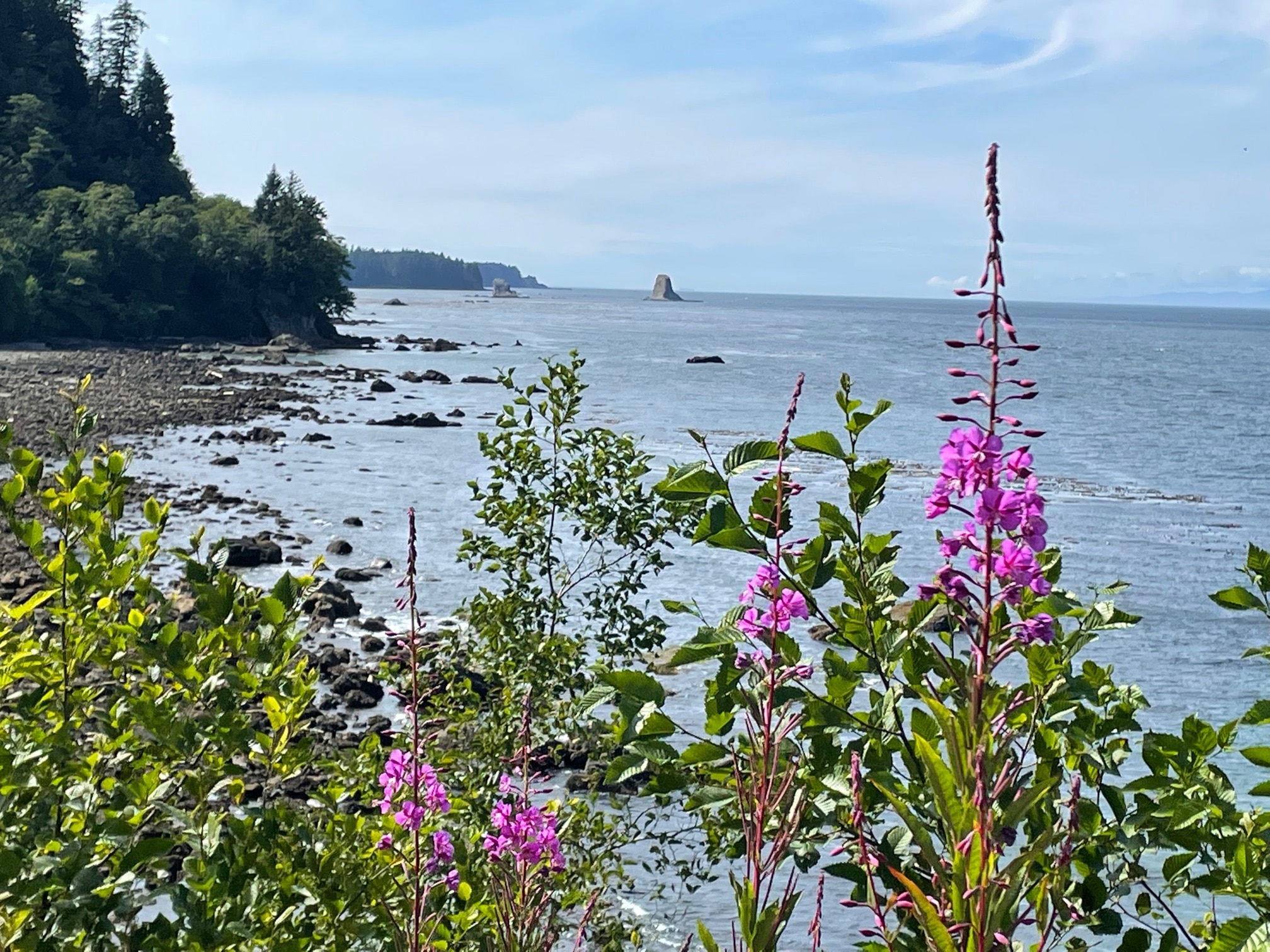
On the country park side of Salt Creek, low tides expose acres of tidepools and forests of mussels. A kelp bed along the point attracts an array of sea life and birds. I watched a heron fish and a bald eagle fly overhead. A small island is also accessible at low tide and provides a great viewpoint of Crescent Beach and the Canadian shore across the Strait to the north.
From my island viewpoint, I was treated to quite a show. Two river otters lunged their way down the beach along the channels of Salt Creek. They plunged into the ocean waters and began their breakfast, feasting on small silver fish.
The Crescent Beach RV Park sits just on the other side of the road from the beach. I plugged the e-Tofino into the 30amp power circuit and began my first meal in the van. The folks at PacWesty have thought of just about everything to make a camper van trip easy and accessible. The e-Tofino is loaded with essentials. The induction stove was excellent, heating my food but not the van. The kitchen gear was everything I needed. The box of electrical adapters provides various options (120v/15a, 120v/20a, 120v/30a, 240v/50a) for adding travel range when you can’t access a charging station.
I finished my dinner and then headed to the beach for sunset.
Did I mention that the PacWesty folks have thought of almost everything? I outfitted myself with their extremely comfortable camp chair, a cup of wine, and a wonderful Pendleton blanket, and I sauntered across the street for a spectacular sunset.
During the summer months in the northwest, the sun sets high in the northern hemisphere after sixteen hours of daylight. From the vantage point of Crescent Beach, the sun sets just between the southwestern shores of Canada’s Vancouver Island and the northwest tip of the United States at Cape Flattery. I was not the only one on the beach that night, but I was certainly the warmest and coziest in the cool evening breeze.

After six hours of charging at the RV site, the battery gained another 30 miles of range. I was set for another adventure. I wanted to get as close to the tip of the northwest United States as I could, given the circumstances. I was about 60 miles from Cape Flattery and had a full charge. I was quite sure that I could make it there and back–if it was not for the global COVID pandemic. The reservation of the Makah Nation sits at the entrance to Cape Flattery and to due to their strong sense of communal healthcare, they have closed the reservation to outside visitors and potential vectors, like me. My longing to stand at the mouth of the Juan de Fuca Strait was foiled by a young Makah teenager who was happy to let me know that only two cases of COVID have been recorded on the reservation, and both tribal members recovered. My thwarted adventure, however, was not without a worthy journey.
The road to Cape Flattery is one of the best drives in the Pacific Northwest. From Crescent Beach, highway 112 begins by heading inland for about 20 miles and then meanders along the Strait for an hour or so of breathtaking scenery. The rugged coastline on the southern shore of Juan de Fuca Strait has many access points to explore the twisted geology that shaped this peninsula.
The villages of Clallam Bay and Sekiu (pronounced C-Q) are the most prominent towns along the drive. But don’t blink. These two hamlets, located on either side of the arching Clallam Bay, have a total year-round population of less than 500. Yet, in the heart of summer, it felt like there were more recreational vehicles and fishing boats in the Sekiu harbor than 10 times their official population. There is an RV park here situated right on the bay. If you have a hankering for fried fish, the By the Bay Café can satisfy your appetite, but don’t expect gourmet cuisine.
At the end of the day, I had traveled 118 miles on the e-Tofino and arrived back at the Crescent Beach RV Park with 40 miles of range left, validating the 150-mile range of the van. As I estimated, I certainly could have reached Cape Flattery and back on a single charge, albeit with just a few electrons to spare. The portion of Highway 112 that I did not get to on the Makah reservation is one of Washington State’s designated Scenic Byways, the first tribal road in the nation to be awarded this distinction.
After another glorious northwest sunset, I was ready for a restful sleep and a trip up the Sol Duc valley on the second full day of my carbon-free Olympic peninsula excursion.
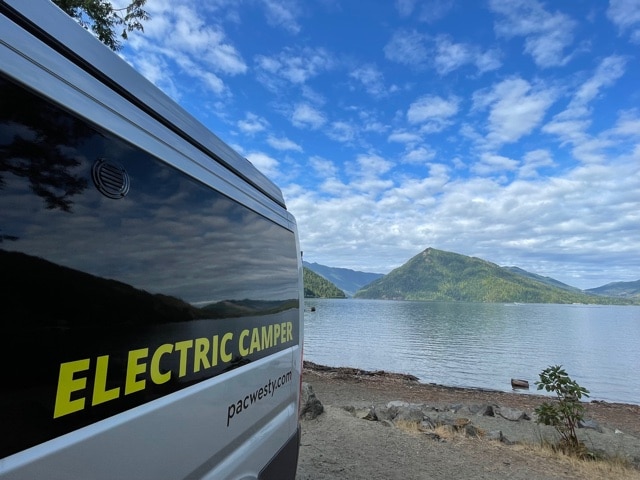
After charging for a little over 12 hours, I gained 80 miles of range on the e-Tofino. This gave me over 120 miles for my adventure up the valley. I say “up” because there is a decent elevation gain getting to the Sol Duc hot springs and trailhead. One thing to know about traveling carbon-free on battery power is that you become much more attuned to elevation and temperature changes. Powering a camper up steep slopes takes much more power and drains the battery much faster. Conversely, using the momentum of the e-Tofino to go downhill allows the regenerative brakes to charge the battery instead of depleting it. Temperature also affects the battery range with colder weather reducing the capacity. The 65 degrees on this summer day, however, was optimal for my battery’s range.
The route from Crescent Beach to Sol Duc begins by skirting the tiny town of Joyce, once in competition to be the Clallam County seat. There is a historic general store that is over a century old. The Joyce-Piedmont road slowly climbs south to a ridge that borders Lake Crescent on the north. At the summit, the landscape morphs from coastal grasses and pines to the rainforest flora of ferns, cedars, and Douglas firs. The road narrows as it drops to the shores of Lake Crescent.
Lake Crescent was formed by a glacier thousands of years ago. Its water descends over 600 feet below its surface and its relative lack of nitrogen prevents algae growth, creating a crystalline clear body of water. Looking across the lake to the south, you see the Olympic Mountain range, on which more glaciers have carved the granite into spectacular ridges, cirques, and peaks.
There are two notable stops along the north shore of Lake Crescent. The Log Cabin RV and Campground is a National Park service run resort. It includes a restaurant, deli, boat rentals (paddle boats, stand-up paddleboards, canoes, kayak), and general store (beer, wine, sandwiches, ice cream, candy, seasonal clothing items).
The second spot is the East Beach Day Use Area which features easy parking spots on the edge of the lake, picnic tables, and porta-potties.
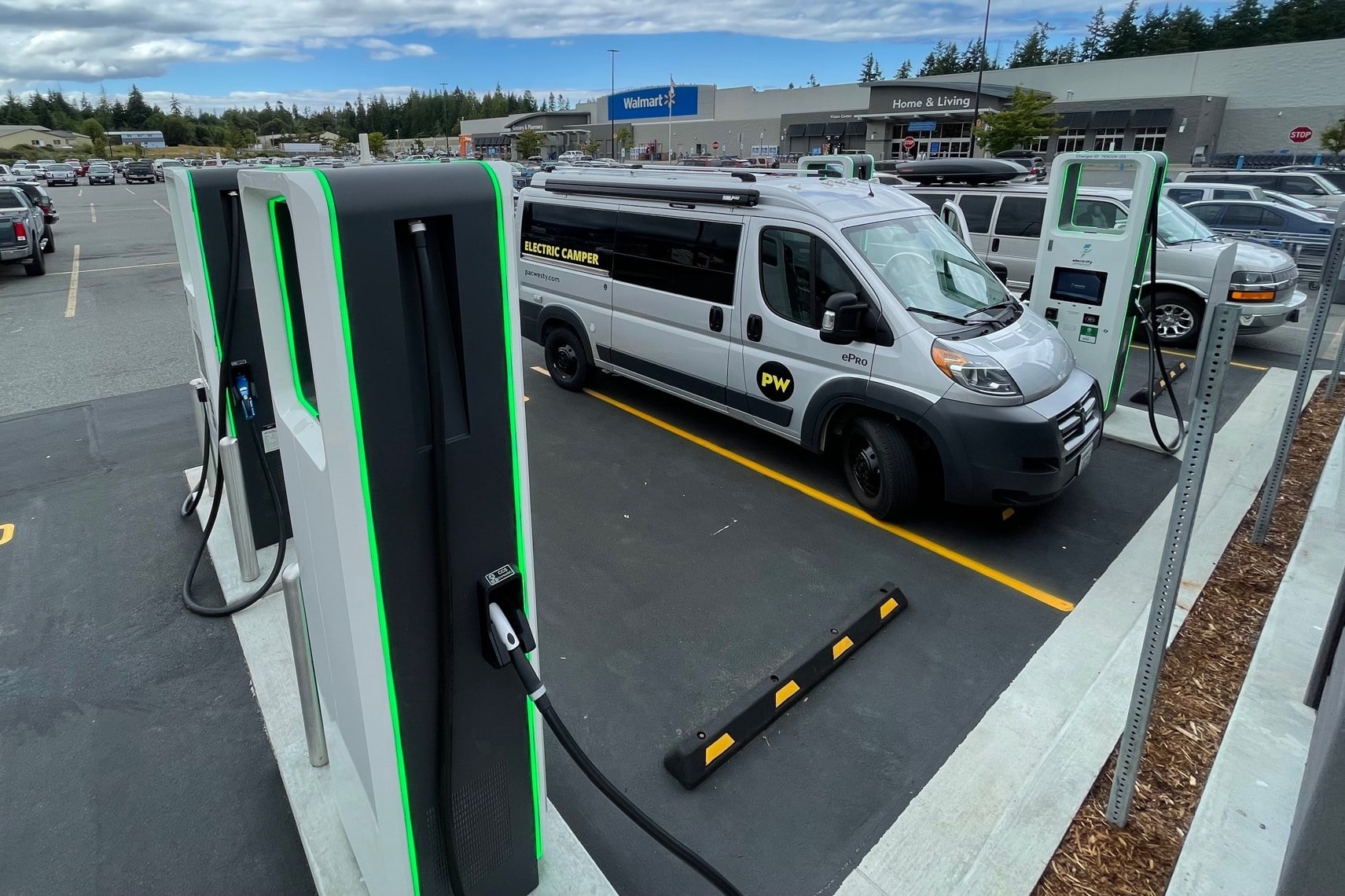
As you connect to highway 101 and turn to the west, the road follows the southern shore of Lake Crescent for eleven gorgeous miles. About midway along that drive is a small peninsula that juts out into the lake. It is the site of the Lake Crescent Lodge and the trailhead for the Marymere Falls, a 1.7 mile, out and back trail. The turn of the century lodge sits on a sandy beach and has a lovely restaurant on the veranda.
Just a few miles further to the west is the turnoff to the Sol Duc Valley. Here, the road begins to climb the 14 miles to the Sol Duc Falls trailhead. This is national park land, so a pass is required at the toll booth. The 3-day pass for the Olympic National Park costs $30. If you are on a more ambitious road trip, you can get in free with an American the Beautiful National pass, giving you access to more than 2,000 federal recreation sites for just $80 per year. I recommend getting to the toll booth early in the day, as the line of cars can pile up, especially in high tourist season. Another reason to get there early is so that you can secure a coveted session at the Sol Duc Hot Springs resort. When I arrived at the resort after 12 miles of travel up the valley, I choose to sign up for a session about four hours later in the day so I could enjoy the trail and come back to the resort after a hike. It cost $15 for the hour and a half hot springs session.
The trail to Sol Duc Falls is a short, relatively flat 0.8 miles. It is well travelled and well worth it. The river cascades through a gap in the rock formation, plunging about 50 feet. There are great views from a bridge and deck overlooks. The trail continues up the river for more adventure, or up the steep slope to Deer Lake.
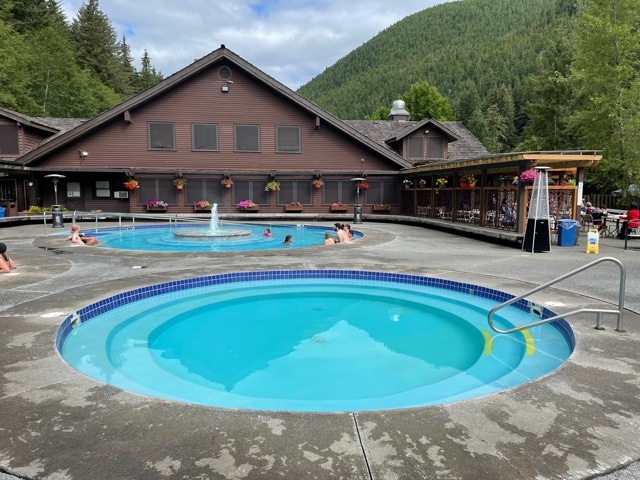
Returning to the Sol Duc Hot Springs after a good walk in the woods is a treat. The resort boasts a delicious restaurant and well-fortified gift store. The natural mineral hot springs supply three soaking pools of varying temperatures, 99 to 107 degrees when I was there. There is also a large, cold water pool for swimming and cooling off. The resort lets 100 people in at a time for the hour and a half session. Legend has it that a dragon living in the Sol Duc Valley is responsible for the naturally heated mineral springs, fuming after an unsuccessful battle with the dragon occupying the Elwah valley to the east.
The e-Tofino had about a 70-mile range left after driving from the Crescent Beach RV Park. Fortunately, the Sol Duc Hot Springs has two SemaConnect level two (L2) chargers toward the north side of their parking lot. It was a convenient place to top off the battery, as I soaked in the hot springs. I plugged in for two hours and gained 15kWh of energy, increasing the battery range by about 30 miles. Not only was it convenient, but it was also free, courtesy of the National Park service.
With over 110 miles of battery range, many other destinations on the Olympic Peninsula were within my grasp. I could have made the 41-mile trip to Forks or continued another 13 miles to the Pacific Ocean at the indigenous village of La Push. If I were to be more ambitious, I might have been able to go all the way to Lake Quinault, 109 miles away. The spectacular Dungeness spit sand bar that extends nearly seven miles into the Strait of Juan de Fuca was only 60 miles away and the alpine peaks of Hurricane Ridge were just 54 miles, and 5,000 feet elevation climb, away.
But alas, the clock was the greatest constraint on my adventure. I had to get back to Coyle for my last night and then return the e-Tofino to Bainbridge Island the next morning. I calculated that it would require about an 80% charge leaving Port Angeles to complete that trip, so I turned east on Highway 101 to find the other fast-charger in Clallam county’s largest city.

After some detours and tourist jaunts, I arrived at the Gateway Transit Center fast-charging station. It is located on the lower level of the transit center in downtown Port Angeles and accessible from East Railroad Avenue on the north. The charger is operated by Greenlots and has both a CHAdeMO and a CCS charger. As this station was developed long before the idea of an all-electric camper van, the parking spaces are not optimal for a 17-foot vehicle. The charging site also borders a parking garage with a 7’-6” clearance, too low for the e-Tofino to enter. It took a couple of minutes to figure out how to maneuver the camper van into a place to charge it without decapitating it, but I did manage to park perpendicular to the charging station and successfully plugged in.
The battery was down to 42% and the charger let me know that it had 44 kW of active charging power. I calculated that I needed about 30 kWh of additional charge to complete my trip and estimated that it would take about 40 minutes of charging to accomplish. [30/44 = 68% of one hour, or 40.9 minutes]
So, I went to explore the Port Angeles waterfront and to find a good place for a meal.
The waterfront at Port Angeles looks out onto a bay protected by the Ediz Hook, a narrow sand spit. On the furthest end of the spit, the US Coast Guard houses its oldest permanent Air Station on the Pacific Ocean. In between the waterfront and the Ediz Hook lies a modest industrial port and a terminal linking this tip of the United States to Canada via the Blackball Ferry.
Along the piers, the Olympic Coast Discovery Center provides a great resource for planning more exploration on the Olympic Peninsula, including information on the 3,188 square mile Olympic Coast National Marine Sanctuary. The Feiro Marine Life Center, just steps away, allows visitors to get an up-close-personal look at the robust marine life found in the waters of the Sanctuary.
The Port Angeles Wharf sits within a hundred yards of the charging station, so it is an excellent destination while charging. It houses art galleries and several restaurants. For dinner, I chose a fairly new, wood-fired pizza and artisan salad venue appropriately called the Roosevelt. The Olympic National Park owes its existence to President Franklin Roosevelt, who toured the peninsula in the 1930s and nominated it to national park status within months of exploring it. The wood-fired pizza was gourmet quality and the outdoor seating in the early summer evening was superb.
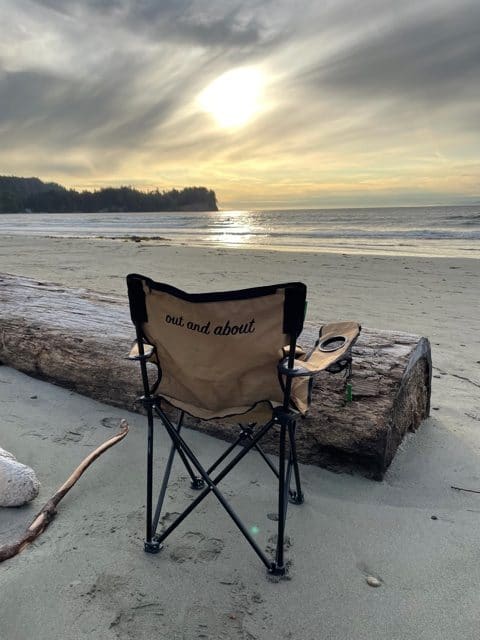
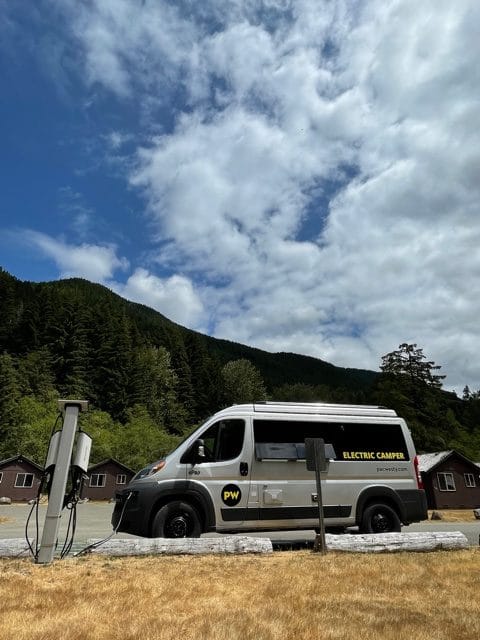
When I arrived back at the e-Tofino, 46 minutes had gone by. The DC fast-charger had delivered 29.2 kWhs to the battery, increasing the charge level to 80%. This was my target, knowing that I had 100 miles to drive before turning the electric van back to PacWesty. After a full day of adventure and now with a full stomach, I carefully backed out the e-Tofino and headed east on Highway 101 to the Tonados peninsula for my last night on the road.
The 14-mile Tonados peninsula dips into hood canal just south of the floating Hood Canal Bridge on the east side of the Olympic peninsula. To its east, the landmass creates Dabob Bay, a relatively undeveloped appendage of the Puget Sound and Hood Canal. The views to the west from the small town of Coyle feature symmetrical 6,800 feet high peaks in the Olympics across Dabob Bay named the Brothers by surveyor George Davidson in 1856. The north peak is named for Arthur Fauntleroy and the south peak is named for Edward Fauntleroy. Davidson’s fiancée, Ellinor, and her sister Constance were also etched into Olympic geographic history on peaks of 5,915 and 7,765 feet high.
My final night was spent in the parking strip of a friend’s cabin. Since I still had enough battery, I did not need to plug in. I knew that I still had 40 miles of range for the final 20 miles trip back to the PacWesty headquarters.
I began to write this journal of my adventure the next morning while looking over a light fog lifting over Dabob Bay. By noon, I had returned the e-Tofino to Luke. I had 15 miles of range left on the battery and a strong desire to continue my adventure left in my soul.
In the end, I had traveled 416 miles in three days across the spectacular Olympic peninsula. It cost me $20.72 in fuel. If I was driving an ICE vehicle at today’s gasoline prices, my cost per mile would have equaled that of a vehicle with a fuel efficiency of 80-miles per gallon. And, I was pulling two beds, a kitchen, and a living room behind my driver’s seat.
It was a road trip of a lifetime.
No hassles.
No carbon emissions.
No kidding.
The taste of this carbon-free adventure left me yearning for more. I am on the verge of never using a gas station again in my life, and I’m thrilled at that prospect.
Written & Photos By: Michael Mann


